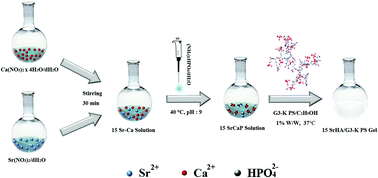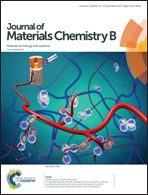Injectable strontium-doped hydroxyapatite integrated with phosphoserine-tethered poly(epsilon-lysine) dendrons for osteoporotic bone defect repair†
Abstract
The control of the inflammatory response induced by the implantation of foreign biomaterials is fundamental in determining tissue healing. It has been shown that the activation of specific macrophage pathways upon contact with a biomaterial can lead either to a chronic inflammation preventing a physiological tissue repair or to an improved tissue healing. In the case of bone repair, calcium phosphate cements with good osteoconductivity properties have been successfully applied in bone defect filling and repair, but poor handling properties, insufficient viscous flow and unmatched degradation rate are still problems that remain unsolved. In this study, a strontium-doped hydroxyapatite (HA) gel was modified by integrating branched poly(epsilon-lysine) dendrons with third-generation branches exposing phosphoserine (SrHA/G3-K PS). The interaction of this material with macrophages was investigated in vitro, focusing on the secretion and gene expression of specific pro-inflammatory cytokines. Our results showed that the addition of strontium and G3-K PS to HA sol–gel could down-regulate the gene expression of inflammatory factors such as IL-1β, TNF-α and MCP-1, while increasing the gene expression of IL-6, a cytokine known for its osteogenic effect. These results were further confirmed by ELISA test of the respective protein concentrations. When exposed to supernatants of macrophage culture in the presence of strontium and G3-K PS, osteoblast viability was promoted with elevated osteogenic gene markers, in terms of OPG, ALP, OCN and COL-I. In vivo implantation experiments using an osteoporotic rat model with bone defect further confirmed that the addition of G3-K PS to HA could dramatically promote new bone regeneration. Although the introduction of strontium improved the degradation properties of the injectable materials, no positive effect on promoting in vivo bone regeneration was observed.



 Please wait while we load your content...
Please wait while we load your content...